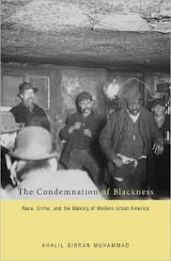Khalil Gibran Muhammad’s The Condemnation of Blackness: Race, Crime, and the Making of Modern Urban America, shows how American sociologists in the late 19th and early 20th century were both affected by and an influence on the racists attitudes of the time. As seen in Worse Than Slavery: Parchman Farm and the Ordeal of Jim Crow Justice by David Oshinsky, blacks were imprisoned at far higher rates than whites after the civil war to enforce racial hierarchies and also for the economic benefit of whites. In the Progressive Era there was a call for reform to make their statements more objective by using more data. The sociologist doing this research found blacks were much more likely to be diseased, to die at an early age, and much more likely to go to jail. Muhammad shows that even if these numbers were totally accurate the sociologist’s interpretations of them were flawed. They only distinguished blacks from whites; they did not differentiate between any other immigrant groups. They also did not look at any other social or environmental causes for the increased imprisonment. These researchers assumed this was due to the fact that blacks were inherently inferior so it was useless to help them. This in turn led to less allocation of fund for black neighborhoods, which led to more imprisonment, and the cycle started all over.
The Condemnation of Blackness had many strong points. Muhammad approaches his subject matter from a very unique perspective looking at racist’s attitudes in the fields of sociology and in the North. This shows how pervasive racism was at the time and it is an encouragement for other historians to look beyond just the South when dealing with racism. A good example of this is when Muhammad said Northern whites thought of blacks as distant Southerners so they were uncomfortable with blacks living next door. He also mentioned how sociologists tried to use statistics to bridge the gap between North and South after the civil war even though the interpretation of these numbers was still racist. Another strong point is Muhammad’s discussion of the major theme of Justice. He shows that the justice system is not perfect but socially constructed even if people are using data their interpretations can still be influenced by their attitudes towards race. This should make the reader question the fairness of the justice system in the past as well as in the present. Another interesting point Muhammad brings up is how attitudes change. He does a good job of showing how people, including some African Americans of the time, used social Darwinism to justify their racist attitudes. Muhammad goes on to show how sociologists broadened their explanation for black criminality as more African-American sociologists were being taken seriously in this field.
There were also several weak points to The Condemnation of Blackness. Although Muhammad’s argument is sound his writing style is not as clear as Oshinsky. He, at times, skips around on the topics he is covering and has generalities without giving specific evidence to support his claim. He also focuses on Philadelphia in several of his chapters. His argument is convincing but he does not explain enough how Philadelphia is an accurate representation of all of the North.
Muhammad’s use of sources is impressive but may not be applicable to the attitudes of the broader public. Muhammad used a variety of sociologist’s books such as, W.E.B. Dubois, to a black author with racist’s views, to northern liberals, and southern writers. He does a good job of showing the impact that these works had to the thinking of the time period. However, one hesitation at using these sources is one could as how much do academic writings really affect the general populace? He should have been more clear as to who these writers influenced but he does a good job of explaining their impact on the people who did read these books.
The Condemnation of Blackness: Race, Crime, and the Making of Modern Urban America by Khalil Gibran Muhammad
Filed under US History



